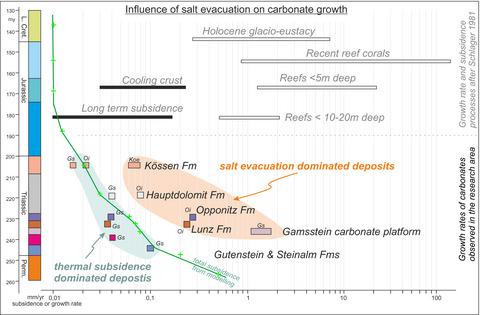当前位置:
X-MOL 学术
›
Basin Res.
›
论文详情
Our official English website, www.x-mol.net, welcomes your feedback! (Note: you will need to create a separate account there.)
Subsidence analysis of salt tectonics‐driven carbonate minibasins (Northern Calcareous Alps, Austria)
Basin Research ( IF 3.2 ) Pub Date : 2020-08-08 , DOI: 10.1111/bre.12500 Philipp Strauss 1, 2 , Pablo Granado 1 , Josep Anton Muñoz 1
Basin Research ( IF 3.2 ) Pub Date : 2020-08-08 , DOI: 10.1111/bre.12500 Philipp Strauss 1, 2 , Pablo Granado 1 , Josep Anton Muñoz 1
Affiliation

|
Subsidence analysis study for several Triassic carbonate platforms from the eastern Northern Calcareous Alps shows that salt expulsion allowed for the growth of thick isolated depocentres (>1.5 km) at rates faster than those tectonic subsidence alone can provide. Our results, in addition to independent regional geological evidence, argue against previous models of thick‐skinned extension controlling accommodation space. Differential sedimentary loading and stretching of the salt layer can explain the development of the Triassic isolated carbonate platforms in the Northern Calcareous Alps, with salt expulsion being proportional to the growth potential of the carbonate producers. Aside of topographic loads, early diageneses of carbonates allow for the density inversion between sediment and salt, with differential loading by carbonate aggradation leading to a self‐sustained feedback cycle of density‐driven and gradient load subsidence; stretching of the salt layer and extensional deformation of its overburden, as constrained by cross‐section restoration, also contributed to diapir initiation and salt expulsion. Our model can: (a) explain the occurrence of isolated Middle Triassic carbonate platforms in the eastern Northern Calcareous Alps, and (b) differentiate between accommodation space controlled by (local) salt expulsion and by (regional) tectonic subsidence. The Triassic Neo‐Tethys shelf of the studied area constituted therefore a salt wall and minibasin province. This contribution and methods herein can also be applied to other carbonate platform systems developed on salt basins, especially where the transition from rift to drift remains unclear.
中文翻译:

盐构造驱动的碳酸盐小盆地的沉降分析(北钙质阿尔卑斯山,奥地利)
对北部钙质阿尔卑斯山东部的几个三叠纪碳酸盐台地的沉降分析研究表明,排盐使较厚的孤立沉积中心(> 1.5 km)的生长速度快于单独的构造沉降所能提供的速度。除了独立的区域地质证据外,我们的结果还与以前的厚皮扩展控制居住空间模型相抵触。盐层的不同沉积载荷和伸展作用可以解释北部钙质阿尔卑斯山三叠系孤立的碳酸盐台地的发育,排盐量与碳酸盐生产者的增长潜力成正比。除了地形负荷外,碳酸盐的早期成岩作用还允许沉积物和盐之间的密度反演,碳酸盐凝结产生的不同负荷导致密度驱动沉陷和梯度沉陷的自我维持的反馈周期;盐层的伸展和上覆岩层的延伸变形(受断面恢复的限制)也促进了成土期的启动和排盐。我们的模型可以:(a)解释北部钙质阿尔卑斯山东部孤立的中三叠统碳酸盐台地的发生,以及(b)区分受(局部)排盐控制和(区域)构造沉降控制的居住空间。因此,研究区域的三叠纪新特提斯大陆架构成了 受到断面修复的限制,也促进了底辟的萌生和排盐。我们的模型可以:(a)解释北部钙质阿尔卑斯山东部孤立的中三叠统碳酸盐台地的发生,以及(b)区分由(局部)排盐控制和(区域)构造沉降控制的居住空间。因此,研究区域的三叠纪新特提斯大陆架构成了 受到断面修复的限制,也促进了底辟的萌生和排盐。我们的模型可以:(a)解释北部钙质阿尔卑斯山东部孤立的中三叠统碳酸盐台地的发生,以及(b)区分受(局部)排盐控制和(区域)构造沉降控制的居住空间。因此,研究区域的三叠纪新特提斯大陆架构成了盐墙和小流域省。本文中的这种贡献和方法也可以应用于在盐盆上开发的其他碳酸盐平台系统,尤其是在从裂谷到漂移的过渡仍不清楚的地方。
更新日期:2020-08-08
中文翻译:

盐构造驱动的碳酸盐小盆地的沉降分析(北钙质阿尔卑斯山,奥地利)
对北部钙质阿尔卑斯山东部的几个三叠纪碳酸盐台地的沉降分析研究表明,排盐使较厚的孤立沉积中心(> 1.5 km)的生长速度快于单独的构造沉降所能提供的速度。除了独立的区域地质证据外,我们的结果还与以前的厚皮扩展控制居住空间模型相抵触。盐层的不同沉积载荷和伸展作用可以解释北部钙质阿尔卑斯山三叠系孤立的碳酸盐台地的发育,排盐量与碳酸盐生产者的增长潜力成正比。除了地形负荷外,碳酸盐的早期成岩作用还允许沉积物和盐之间的密度反演,碳酸盐凝结产生的不同负荷导致密度驱动沉陷和梯度沉陷的自我维持的反馈周期;盐层的伸展和上覆岩层的延伸变形(受断面恢复的限制)也促进了成土期的启动和排盐。我们的模型可以:(a)解释北部钙质阿尔卑斯山东部孤立的中三叠统碳酸盐台地的发生,以及(b)区分受(局部)排盐控制和(区域)构造沉降控制的居住空间。因此,研究区域的三叠纪新特提斯大陆架构成了 受到断面修复的限制,也促进了底辟的萌生和排盐。我们的模型可以:(a)解释北部钙质阿尔卑斯山东部孤立的中三叠统碳酸盐台地的发生,以及(b)区分由(局部)排盐控制和(区域)构造沉降控制的居住空间。因此,研究区域的三叠纪新特提斯大陆架构成了 受到断面修复的限制,也促进了底辟的萌生和排盐。我们的模型可以:(a)解释北部钙质阿尔卑斯山东部孤立的中三叠统碳酸盐台地的发生,以及(b)区分受(局部)排盐控制和(区域)构造沉降控制的居住空间。因此,研究区域的三叠纪新特提斯大陆架构成了盐墙和小流域省。本文中的这种贡献和方法也可以应用于在盐盆上开发的其他碳酸盐平台系统,尤其是在从裂谷到漂移的过渡仍不清楚的地方。



























 京公网安备 11010802027423号
京公网安备 11010802027423号